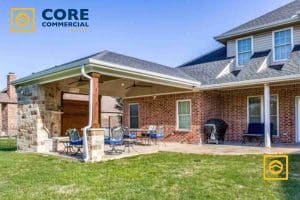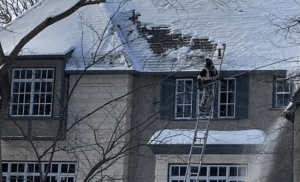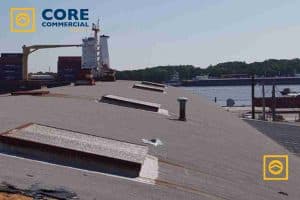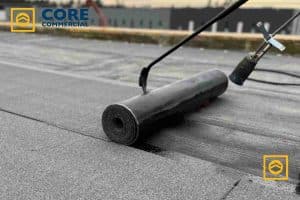There are several main types of commercial roofing systems: TPO, EPDM, PVC, Metal, Built-Up Roofing (BUR), and Modified Bitumen. TPO is affordable and energy-efficient, reflecting UV rays to lower cooling costs. EPDM offers strong durability and weather resistance. PVC is chemical- and fire-resistant, ideal for industrial buildings. Metal roofing provides long-lasting protection with low maintenance, while BUR and Modified Bitumen deliver durable, waterproof layers suited for heavy traffic. The best choice depends on your building’s climate, budget, and maintenance needs. Consulting a roofing professional helps ensure you choose the most efficient and cost-effective system for long-term performance.
Table of Contents
What Are Commercial Roofing Systems?
Commercial roofing systems are designed to protect large structures like warehouses, office buildings, restaurants, retail spaces, and industrial facilities. Unlike residential roofs that usually have steep slopes and are made of shingles or tiles, commercial roof types are often flat or low-sloped.
Because of these flatter designs, they need materials that can handle pooling water, extreme temperatures, foot traffic, and equipment installations like HVAC units. That’s why commercial roof systems are typically made from more durable, weather-resistant materials and installed using specific methods that prioritize performance over aesthetics.
Understanding the differences between each system can help you avoid costly mistakes and long-term maintenance headaches. Let’s break down the most popular commercial roof systems available today.
Built-Up Roofing (BUR): Old-School Reliability
Built-Up Roofing—often called “tar and gravel” roofs—has been around for over a century. It’s made of alternating layers of bitumen (asphalt) and reinforcing fabrics, finished with a layer of gravel or a reflective coating.
Why businesses choose BUR:
- Strong weather resistance due to its multi-layer structure
- Good fire protection (especially with gravel on top)
- Thick layers help reduce heat transfer and noise
What to consider:
BUR can be time-consuming and labor-intensive to install. It’s also heavier than other systems, which means your building needs to be able to handle the load. Repairs can be tricky, too, as finding the exact leak source under multiple layers is challenging.
Best for: Flat roofs that need high durability and insulation, especially in areas with hot sun or fire risks.
Modified Bitumen Roofing: The Flexible Upgrade
Think of modified bitumen as a modern twist on BUR. Instead of traditional asphalt layers, it uses rubber or plastic modifiers that make it more flexible and resistant to cracking.
Why it works well:
- More flexibility in cold and hot climates
- Comes in peel-and-stick, torch-down, or cold adhesive options
- Can handle foot traffic better than many other systems
Considerations:
It offers slightly better durability than BUR and can be easier to install. But it’s still more labor-intensive compared to single-ply membranes like TPO or EPDM.
Best for: Buildings that need a durable but more modern roof with better flexibility.
EPDM Rubber Roofing: The Long-Term Performer
EPDM stands for Ethylene Propylene Diene Monomer—a fancy name for synthetic rubber. It’s one of the most cost-effective and long-lasting flat roofing systems out there.
Key benefits:
- Lasts 30+ years with proper maintenance
- Available in large sheets, which means fewer seams = fewer leak points
- Black EPDM absorbs heat in colder areas; white versions reflect sun for energy savings
What to keep in mind:
It’s not the most stylish, but it gets the job done. It’s also sensitive to sharp objects or heavy foot traffic, so occasional inspections are essential.
Best for: Cost-conscious business owners looking for durability and simple maintenance.
TPO Roofing: Energy Savings Without the High Cost
TPO (Thermoplastic Olefin) is one of the fastest-growing types of commercial roof systems—and for good reason. It’s budget-friendly, energy-efficient, and relatively easy to install.
Why TPO stands out:
- Reflects UV rays to keep buildings cooler
- Comes in white or light colors to boost energy savings
- Can be mechanically attached or fully adhered
- Typically lasts 20–30 years
Considerations:
The material can vary in quality depending on the manufacturer, so it’s crucial to work with a contractor familiar with proper installation techniques.
Best for: Businesses focused on energy efficiency and cost-effective installation.
PVC Membrane Roofing: High Performance for Tough Jobs
PVC (Polyvinyl Chloride) is a single-ply membrane that’s strong, chemical-resistant, and fire-retardant. It’s popular in places like restaurants or factories where exposure to grease or chemicals is common.
PVC’s strong points:
- Extremely durable under chemical exposure
- Fire-resistant and strong seams thanks to heat welding
- Reflective surface helps with energy bills
Watch out for:
PVC roofs can be more expensive than TPO or EPDM, but they often make up for it with performance and durability.
Best for: Industrial or commercial buildings exposed to harsh substances or fire hazards.
Metal Roofing: Built to Last Decades
Metal roofs aren’t just for barns and warehouses anymore—they’re now a popular, long-lasting choice for many commercial structures.
Top benefits:
- Can last 40–70 years
- Withstands wind, hail, and snow
- Reflects solar heat to reduce cooling costs
- Lightweight and recyclable
Potential drawbacks:
Noise during storms and a higher upfront cost. However, the low maintenance and extreme lifespan make it worth the investment for many.
Best for: Long-term building owners who want a low-maintenance, high-performance roof.
Green Roofing Systems: The Eco-Friendly Option
Green roofs are exactly what they sound like—living plants grown over a waterproof membrane. They’re becoming more popular in cities and eco-conscious communities.
Benefits include:
- Natural insulation helps with energy savings
- Reduces stormwater runoff
- Creates habitat for wildlife and improves air quality
Things to consider:
Higher upfront costs, plus the need for structural support and ongoing maintenance. But the energy savings and environmental impact can pay off over time.
Best for: Businesses aiming for sustainability, energy efficiency, and LEED certifications.
Comparing Roof Types: What Matters Most
Here’s a quick side-by-side look at common commercial roofing systems:
|
Roofing Type |
Lifespan |
Energy Efficiency |
Maintenance |
Best For |
|
BUR |
20–30 years |
Moderate |
Medium |
Durability on flat roofs |
|
Modified Bitumen |
20–30 years |
Moderate |
Medium |
Flexibility in temperature swings |
|
EPDM |
30+ years |
High (white) |
Low |
Budget-conscious owners |
|
TPO |
20–30 years |
Very High |
Low |
Energy savings, cost-efficiency |
|
PVC |
25–35 years |
High |
Low |
Chemical or fire-prone areas |
|
Metal |
40–70 years |
High |
Very Low |
Long-term investment |
|
Green Roofing |
30–50 years |
Very High |
Medium–High |
Eco-friendly businesses |
Tips for Choosing the Right Commercial Roofing System
- Consider the climate. Hot, sunny areas benefit from reflective roofs like TPO or PVC.
- Look at your budget. Don’t just focus on the upfront cost—factor in lifespan and maintenance.
- Think about foot traffic. If workers frequently access the roof, choose something that handles wear and tear.
- Assess your goals. Are you aiming for energy efficiency? Longevity? Sustainability? Match your roof to your priorities.
- Work with experienced pros. A great product poorly installed won’t last.
Commercial Roof Maintenance Must-Knows
Even the best roof won’t last long if it’s ignored. Create a regular maintenance plan that includes:
- Bi-annual inspections (spring and fall)
- Clearing drains and gutters
- Checking for membrane damage or loose flashing
- Repairing small issues before they grow
- Keeping a log of repairs and inspection notes
Preventive care goes a long way in protecting your investment.
Common Roofing Issues and How to Prevent Them
Leaks are the #1 complaint with commercial roof types. These often come from poor installation, cracked seams, or neglected maintenance.
Ponding water can lead to rot, mold, and leaks if drainage isn’t working properly.
Membrane damage from foot traffic, tools, or sharp debris should be addressed right away.
Solution: Invest in annual inspections, quick repairs, and proper staff training for rooftop access.
Final Thoughts on Selecting a Commercial Roof
There’s no one-size-fits-all answer when it comes to choosing the best commercial roofing system. Every business is different—what works for a warehouse might not suit a downtown office or retail building.
The key is to understand your building’s needs, the conditions it’s exposed to, and your long-term goals. Whether you’re leaning toward cost-effective EPDM, energy-saving TPO, or a sustainable green roof, making the right decision starts with knowledge.
FAQs
What is the best commercial roofing system for durability?
Metal roofing systems, such as steel or aluminum panels, offer exceptional durability and can last over 50 years with minimal maintenance. They resist harsh weather, including heavy snow, high winds, and hail, and their reflective surfaces help reduce cooling costs by bouncing sunlight away from the building.
How do I choose between EPDM and TPO membranes?
Choosing between EPDM and TPO depends on your priorities: EPDM rubber roofing lasts over 30 years, is easy to install in large sheets, and requires minimal upkeep. TPO offers superior energy efficiency with its reflective surface and often costs less upfront. If long-term durability is key, EPDM is ideal; if energy savings and cost are top concerns, TPO may be the better option.
What are the main benefits of modified bitumen roofing?
Modified bitumen roofing combines traditional asphalt layers with polymer modifiers like fiberglass or polyester for added flexibility and strength. It resists UV degradation, handles temperature fluctuations well, and can be installed via heat welding or adhesive methods. This versatility and resilience make it a cost-effective choice for many commercial projects.
Can I install a new roof over an existing one?
In some cases, installing a new roofing system over an existing roof is possible if the current structure is sound and compatible with the new material. For example, you can layer certain single-ply membranes over an existing BUR or modified bitumen roof. However, a thorough inspection is essential to confirm load capacity and ensure proper adhesion or attachment.
What maintenance is required for built-up roofing?
Built-up roofing (BUR) requires regular inspections for signs of gravel displacement, membrane cracks, or seam issues. Cleaning debris and ensuring proper drainage prevents water pooling that can damage layers. Scheduling professional maintenance twice yearly and after severe weather helps catch and repair minor issues before they become costly leaks or structural problems.
How does green roofing improve energy efficiency?
Green roofing systems add a layer of vegetation over a waterproof membrane, which insulates the building and reduces heat absorption. The plants and growing medium keep indoor temperatures more stable, lowering cooling needs in summer and heating demand in winter. Additionally, green roofs reduce urban heat islands and manage stormwater runoff naturally.
What factors affect commercial roofing costs?
Commercial roofing costs depend on material choice, roof size and slope, labor rates, and installation complexity. Materials like TPO and EPDM have moderate upfront costs and low maintenance, while metal and green roofs are pricier initially but offer long-term savings. Site accessibility, removal of old roofing, and warranty options also influence total project expenses.






